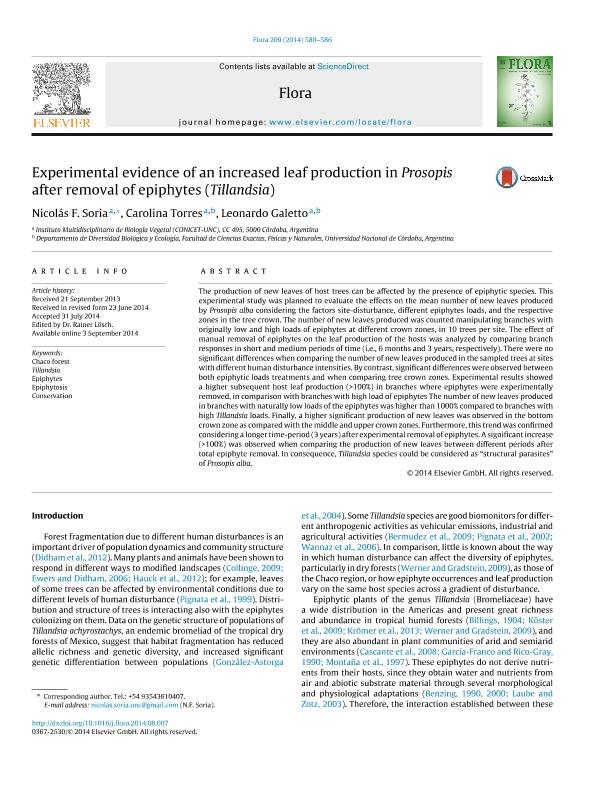Mostrar el registro sencillo del ítem
dc.contributor.author
Soria, Nicolas Franco

dc.contributor.author
Torres, Carolina Cecilia

dc.contributor.author
Galetto, Leonardo

dc.date.available
2018-08-08T17:45:18Z
dc.date.issued
2014-10
dc.identifier.citation
Soria, Nicolas Franco; Torres, Carolina Cecilia; Galetto, Leonardo; Experimental evidence of an increased leaf production in Prosopis after removal of epiphytes (Tillandsia); Elsevier Gmbh; Flora; 209; 10; 10-2014; 580-586
dc.identifier.issn
0367-2530
dc.identifier.uri
http://hdl.handle.net/11336/54602
dc.description.abstract
The production of new leaves of host trees can be affected by the presence of epiphytic species. This experimental study was planned to evaluate the effects on the mean number of new leaves produced by Prosopis alba considering the factors site-disturbance, different epiphytes loads, and the respective zones in the tree crown. The number of new leaves produced was counted manipulating branches with originally low and high loads of epiphytes at different crown zones, in 10 trees per site. The effect of manual removal of epiphytes on the leaf production of the hosts was analyzed by comparing branch responses in short and medium periods of time (i.e., 6 months and 3 years, respectively). There were no significant differences when comparing the number of new leaves produced in the sampled trees at sites with different human disturbance intensities. By contrast, significant differences were observed between both epiphytic loads treatments and when comparing tree crown zones. Experimental results showed a higher subsequent host leaf production (>100%) in branches where epiphytes were experimentally removed, in comparison with branches with high load of epiphytes The number of new leaves produced in branches with naturally low loads of the epiphytes was higher than 1000% compared to branches with high Tillandsia loads. Finally, a higher significant production of new leaves was observed in the bottom crown zone as compared with the middle and upper crown zones. Furthermore, this trend was confirmed considering a longer time-period (3 years) after experimental removal of epiphytes. A significant increase (>100%) was observed when comparing the production of new leaves between different periods after total epiphyte removal. In consequence, Tillandsia species could be considered as "structural parasites" of Prosopis alba.
dc.format
application/pdf
dc.language.iso
eng
dc.publisher
Elsevier Gmbh

dc.rights
info:eu-repo/semantics/openAccess
dc.rights.uri
https://creativecommons.org/licenses/by-nc-sa/2.5/ar/
dc.subject
Chaco Forest
dc.subject
Conservation
dc.subject
Epiphytes
dc.subject
Epiphytosis
dc.subject
Tillandsia
dc.subject.classification
Otras Ciencias Biológicas

dc.subject.classification
Ciencias Biológicas

dc.subject.classification
CIENCIAS NATURALES Y EXACTAS

dc.title
Experimental evidence of an increased leaf production in Prosopis after removal of epiphytes (Tillandsia)
dc.type
info:eu-repo/semantics/article
dc.type
info:ar-repo/semantics/artículo
dc.type
info:eu-repo/semantics/publishedVersion
dc.date.updated
2018-07-23T17:40:50Z
dc.journal.volume
209
dc.journal.number
10
dc.journal.pagination
580-586
dc.journal.pais
Alemania

dc.journal.ciudad
Berlin
dc.description.fil
Fil: Soria, Nicolas Franco. Consejo Nacional de Investigaciones Científicas y Técnicas. Centro Científico Tecnológico Conicet - Córdoba. Instituto Multidisciplinario de Biología Vegetal. Universidad Nacional de Córdoba. Facultad de Ciencias Exactas Físicas y Naturales. Instituto Multidisciplinario de Biología Vegetal; Argentina
dc.description.fil
Fil: Torres, Carolina Cecilia. Consejo Nacional de Investigaciones Científicas y Técnicas. Centro Científico Tecnológico Conicet - Córdoba. Instituto Multidisciplinario de Biología Vegetal. Universidad Nacional de Córdoba. Facultad de Ciencias Exactas Físicas y Naturales. Instituto Multidisciplinario de Biología Vegetal; Argentina
dc.description.fil
Fil: Galetto, Leonardo. Consejo Nacional de Investigaciones Científicas y Técnicas. Centro Científico Tecnológico Conicet - Córdoba. Instituto Multidisciplinario de Biología Vegetal. Universidad Nacional de Córdoba. Facultad de Ciencias Exactas Físicas y Naturales. Instituto Multidisciplinario de Biología Vegetal; Argentina
dc.journal.title
Flora

dc.relation.alternativeid
info:eu-repo/semantics/altIdentifier/doi/http://dx.doi.org/10.1016/j.flora.2014.08.007
dc.relation.alternativeid
info:eu-repo/semantics/altIdentifier/url/https://www.sciencedirect.com/science/article/pii/S0367253014001005
Archivos asociados
